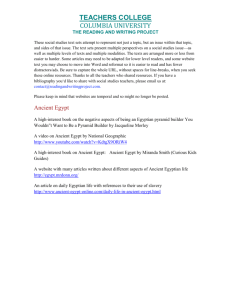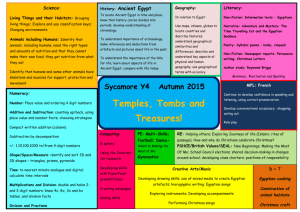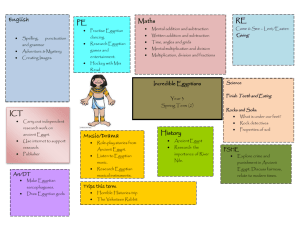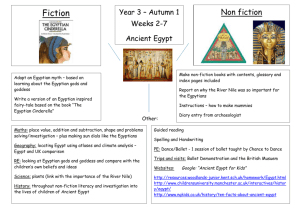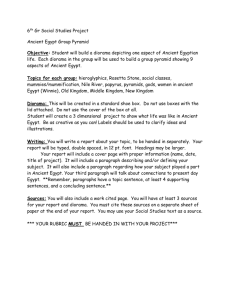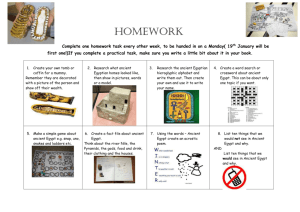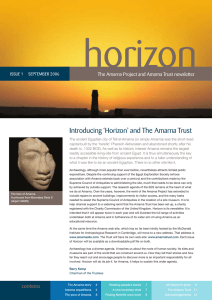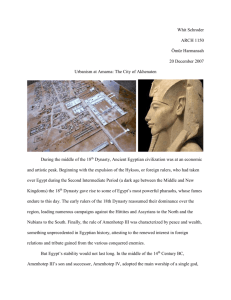EGYT1430 syllabus Fall 2011
advertisement
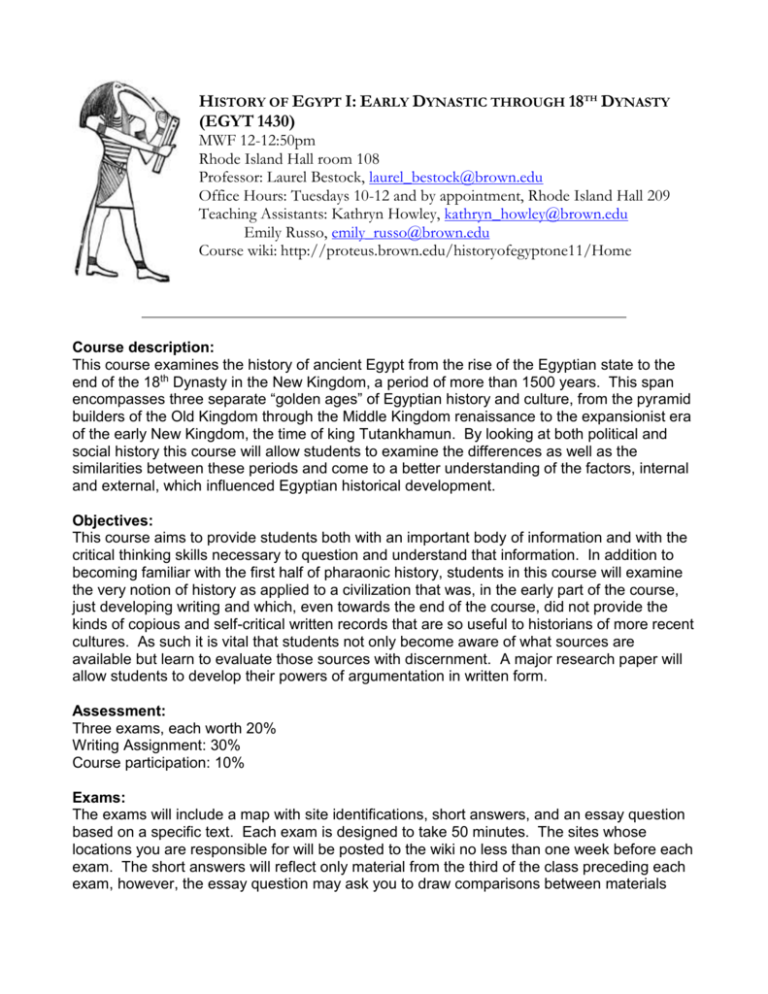
HISTORY OF EGYPT I: EARLY DYNASTIC THROUGH 18TH DYNASTY (EGYT 1430) MWF 12-12:50pm Rhode Island Hall room 108 Professor: Laurel Bestock, laurel_bestock@brown.edu Office Hours: Tuesdays 10-12 and by appointment, Rhode Island Hall 209 Teaching Assistants: Kathryn Howley, kathryn_howley@brown.edu Emily Russo, emily_russo@brown.edu Course wiki: http://proteus.brown.edu/historyofegyptone11/Home Course description: This course examines the history of ancient Egypt from the rise of the Egyptian state to the end of the 18th Dynasty in the New Kingdom, a period of more than 1500 years. This span encompasses three separate “golden ages” of Egyptian history and culture, from the pyramid builders of the Old Kingdom through the Middle Kingdom renaissance to the expansionist era of the early New Kingdom, the time of king Tutankhamun. By looking at both political and social history this course will allow students to examine the differences as well as the similarities between these periods and come to a better understanding of the factors, internal and external, which influenced Egyptian historical development. Objectives: This course aims to provide students both with an important body of information and with the critical thinking skills necessary to question and understand that information. In addition to becoming familiar with the first half of pharaonic history, students in this course will examine the very notion of history as applied to a civilization that was, in the early part of the course, just developing writing and which, even towards the end of the course, did not provide the kinds of copious and self-critical written records that are so useful to historians of more recent cultures. As such it is vital that students not only become aware of what sources are available but learn to evaluate those sources with discernment. A major research paper will allow students to develop their powers of argumentation in written form. Assessment: Three exams, each worth 20% Writing Assignment: 30% Course participation: 10% Exams: The exams will include a map with site identifications, short answers, and an essay question based on a specific text. Each exam is designed to take 50 minutes. The sites whose locations you are responsible for will be posted to the wiki no less than one week before each exam. The short answers will reflect only material from the third of the class preceding each exam, however, the essay question may ask you to draw comparisons between materials discussed over the whole course of the class. There is no final exam; the third exam will be held the last day of scheduled class, and the course will adjourn before Reading Period. Writing assignment: Write a research paper on an approved topic. Topics and preliminary bibliographies must be handed in and approved three weeks prior to the paper due date. It is important to identify a topic that is not too broad, for which there is sufficient information but no synthetic study already completed. You must use original sources in your research (translations of Egyptian texts into any modern language you can read) as well as secondary sources. While you are encouraged to identify topics in part based on the general readings for the course, you must go substantially beyond these general works in amassing a bibliography. Your research should be thorough enough that you have looked at many if not most of the most relevant and recent discussions related to your topic – be warned that you need to exercise considerable foresight in tracking down sources. Use ILL, use JSTOR, etc, and feel free to use my office as a library as well. Failure to consult a source because it is checked out of the Rock is an insufficient excuse. In identifying a topic, it may be helpful to begin by posing questions that you find interesting or identifying areas discussed in class or in the texts that you found ambiguous or unconvincing. You are strongly encouraged to speak to me and/or the TA about potential topics before developing your proposal and bibliography; identifying focused topics is one of the most difficult tasks facing the student of the ancient world and I am more than happy to help you narrow your interests into a feasible question-oriented topic. Your paper should be approximately 2500-3000 words long and must include proper citations. You may use either the notes and bibliography style or the author-date style of citations, provided you are consistent and thorough. The Chicago Manual of Style has a very helpful quick guide online. Failure to cite properly will result in a full grade deduction. Papers will be graded on quality of research, strength of argument, organization and style. Late papers are not acceptable. The paper is due November 18th at midnight, submitted via e-mail to the professor. (You may cc the TA if you want, but only getting it to the professor counts as turning it in on time.) Course Participation: Because this is a moderately sized class, the opportunity to participate in in-class discussions will be somewhat limited. However, discussion is absolutely vital to our project of critically examining evidence. Some Fridays will be reserved for such discussion in class. If it is too crowded for everyone to participate comfortably, we will on occasion split into groups and engage in discussion of the reading led by the instructor and TA. Discussion days will be announced in class and on the wiki one week prior to their occurrence; attendance will be taken at discussion. Questions related to the readings will also be posted on a weekly basis to the wiki, where a running conversation will also take place. All members of the class are encouraged to pose questions in this forum and all will be expected to participate in the ensuing discussion. Failure to attend and take part in discussions, persistent absence from the lecture portion of class, or failure to engage in wiki conversations will result in a lower grade for the participation element of the course. Readings: Readings are listed by week. You are expected to do the reading over the course of the week, and to come to class Friday with it done. All of the required books are in the bookstore. Assigned readings from other texts will be posted to the wiki. On days where we will be EGYT 1430 Page 2 discussing the readings, you should bring your books and/or pdfs with you (printed or on a computer or tablet – doesn’t matter so long as you can access them). Books: Required: Oxford History of Ancient Egypt, Ian Shaw (ed) (this is available in illustrated and unillustrated forms – I suggest the former not only because the illustrations are helpful but because it is larger format and easier to use; page numbers in the syllabus come from this edition) Texts from the Pyramid Age, Nigel Strudwick Ancient Egyptian Literature I, Miriam Lichtheim The Middle Kingdom of Ancient Egypt, Wolfram Grajetzki Suggested (selections from the following will be posted to the wiki as assigned reading, however any student intending to do much study of ancient Egypt should consider owning the following volumes in those cases where they are available): Ancient Egypt: Anatomy of a Civilization, second edition (2005), Barry Kemp Social History of Egypt, Trigger et al Amenhotep III: Perspectives on His Reign, edited by D. O’Connor and E. Cline The above three are strongly recommended Egypt: The World of the Pharaohs, Shultz and Seidel (eds) Complete Pyramids, Mark Lehner Middle Kingdom Studies, Quirke Schedule: Week 1 (Sep. 7, 9): Introduction Readings: Shaw Chapter 1, 1-16 John Moreland Archaeology and Text, Chapter 1, 9-32. “A Push to Redefine Knoweledge at Wikipedia” – NYTimes article Week 2 (Sep. 12, 14, 16): Defining History in the Ancient World Chronology; Political vs. Social History Readings: Shaw, Chapter 2, 17-43 Kemp, Chapter 1, 19-59 William Ward “The Present Status of Egyptian Chronology” BASOR 288 (1992) 53-66 Tait and Uphill in ‘Never Had the Like Occurred’: Egypt’s View of Its Past (ed.) J. Tait, 1-30 Week 3: (Sep. 19, 21, 23) Rise of the State; Development of Writing Reading: Seidlmayer “Egypt’s Path to Advanced Civilization” in World of the Pharahos, 8-23 Shaw chapters 3 and 4, 44-88 Christiana Köhler “The State of Research on Late Predynastic Egypt: new Evidence for the Development of the Pharaonic State?” GM 147 (1995), 79-92 Trigger in Social History, 1-70 (skim) EGYT 1430 Page 3 Baines “Communication and Display: The Integration of Early Egyptian Art and Writing” in Antiquity 63 (1989) 471-82 Brandl “Evidence for Egyptian colonization of the southern coastal plain and lowlands of Canaan during the Early Bronze I Period” in Nile Delta in Transition, 441-76 Week 4 (Sep. 26, 28, 30): Old Kingdom I Reading: Shaw Chapter 5, 89-117 Kemp in Social History part 1: 71-111 Recommended: Kemp Anatomy Chapter 4, 163-192 Week 5 (Oct. 3, 5, 7) Old Kingdom II Reading: Redford “The Egyptian Sense of the Past in the Old and Middle Kingdoms” in Pharaonic King-lists, Annals and Day-books, 127-163 Malek “The Original Version of the Royal Canon of Turin”, JEA 68 (1982) 93-106 Strudwick Intro 1-63 o The Palermo Stone and Associated Fragments 65-73 o Festival Offering Calendar for the Sun Temple of Niuserre 86-91 o Royal Decrees nos. 16-28, p 97-115 o State Administrative Texts, 165-174 o Biographical Texts by number: 198, 200, 205, 212, 227, 232, 241, 242, 243, 247, 256, 269, 273, 274 OCTOBER 7, FIRST EXAM Week 6 (Oct. 12, 14 – no class on the 10th) First Intermediate Period Reading: Shaw chapter 6, 118-147 Strudwick Royal Decrees nos. 29-40, p. 115-124 Brovarski. “Ahanakht of Bersheh and the Hare Nome in the First Intermediate Period” in Simpson and Davies (eds.) Studies in Ancient Egypt, the Aegean and the Sudan (Festschrift D. Dunham) 14-30. Lichtheim, Merikare and EP, 97-112, 169-83 Kemp in Social History, 112-116; 174-182 Suggested: G. Björkman “Egyptology and Historical Method” Orientalia Suecana 13 (1964) 9-33. (This is only recommended, not required, because it is a difficult read. But it is HIGHLY recommended – a very important critique of the uses to which literary sources have been put.) W. C. Hayes “The Middle Kingdom in Egypt: Internal History from the Rise of the Heracleopolitans to the Death of Ammenemenes III” in Cambridge Ancient History I.2, 464-531 (Suggested as an exercise in being critical – he isn’t! Take what Björkman has done, look at how Hayes fails to bring the kind of critical eye Björkman insists upon, and reflect upon other authors and how we read them.) EGYT 1430 Page 4 Fischer “The Nubian Mercenaries of Gebelien during the First Intermediate Period” Kush 9 (1961) 44-80 Week 7 (Oct. 17, 19, 21) Middle Kingdom I Reading: Shaw Chapter 7, 148-183 Grajetzki Part 1, 7-63 C. Vogel “Fallen Heroes?: Winlock’s ‘Slain Soldiers’ Reconsidered” JEA 89 (2003), 239-45 Lichtheim, The Prophecies of Neferti, 139-45; The Story of Sinuhe, 222-35 Week 8 (Oct. 24, 26, 28) Middle Kingdom II Reading: Grajetzki Part 3, 139-166 J. Wegner “The Nature and Chronology of the Senusret III-Amenemhat III Regnal Succession” JNES 55 (1996) 249-79 Kemp, Anatomy of a Civilization Chapter 5: 193-244 Parkinson Voices from Ancient Egypt p. 40-54, 97-112 Lichtheim, 113-20, 123-25, 134-44, 149-63 PAPER TOPIC PROPOSAL AND PRELIMINARY BIBLIOGRAPHY DUE OCTOBER 28 Week 9 (Oct. 31, Nov. 2, 4) Egypt and the Outside World through the Middle Kingdom Reading: Shaw Chapter 11 Kemp in Social History, 116-174 Williams “Serra East and the Mission of Middle Kingdom Fortresses in Nubia” in Gold of Praise, 435-53. NOVEMBER 4: SECOND EXAM Week 10 (Nov. 7, 9, 11) Second Intermediate Period and the transition to the New Kingdom Reading: Bourriau in Shaw Ch. 8, 184-217 Bietak, Manfred. “Canaanites in the Eastern Nile Delta.” Egypt, Israel, Sinai, pp. 4156. Quirke “Royal Power in the 13th Dynasty” in Middle Kingdom Studies Allen, Allen and Ben-Tor, review of The Political Situation in Egypt during the Second Intermediate Period by Kim Ryholt Week 11 (Nov. 14, 16, 18) 18th Dynasty through Thutmosis IV Reading: O’Connor in Social History, 183-232. EGYT 1430 Page 5 Shaw Chapter 9, 218-71 (this gets a little ahead of things; you’ll want to refresh on this next week, too) Dorman “The Early Reign of Thutmose III: An Unorthodox Mantle of Coregency” in Cline and O’Connor Thutmose III: A New Biography, Ann Arbor 2006, 39-68. PAPER DUE NOVEMBER 18TH Week 12 (Nov. 21 and Thanksgiving break) Amenhotep III-Amenhotep IV Murnane “The Organization of Government under Amenhotep III” in Amenhotep III, Perspectives on His Reign, O’Connor and Cline (eds), 173-222 Moran Amarna Letters selections posted to the wiki Refresh on the Shaw Chapter 9 latter half Murnane Texts from the Amarna Period 1-20, 29-31 Week 13 (Nov. 28, 30, Dec. 2) Amarna Baines “The Dawn of the Amarna Age” in Amenhotep III, Perspectives on His Reign, O’Connor and Cline (eds), 271-312 Moran Amarna Letters selections posted to the wiki Murnane Texts from the Amarna Period 73-86, 101-2, 108-120 (This is a slog – the whole tomb of Ay. Do your best with it, paying particular attention to the Great Hymn.) Week 14 (Dec. 5, 7) Post Amarna Shaw 272-287 Murnane Texts from the Amarna Period, 230-33, 235-40 Kemp Anatomy of a Civilization 247-335 THIRD EXAM: DECEMBER 7TH EGYT 1430 Page 6
